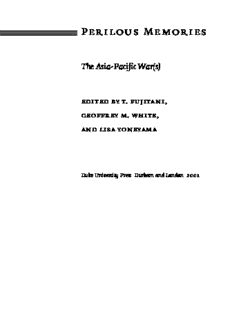Table Of ContentPerilous Memories
The Asia-Pacific War(s)
edited by t. fujitani,
geoffrey m. white,
and lisa yoneyama
Duke University Press Durham and London 2001
Perilous Memories
This page intentionally left blank
Perilous Memories
The Asia-Pacific War(s)
edited by t. fujitani,
geoffrey m. white,
and lisa yoneyama
Duke University Press Durham and London 2001
∫ 2001 Duke University Press
All rights reserved
Printed in the United States of
America on acid-free paper $
Typeset in Quadraat by Keystone
Typesetting, Inc.
Library of Congress Cataloging-in-
Publication Data appear on the last
printed page of this book.
This book is made possible in part
by a subvention from the Japan
Foundation.
Contents
vii Acknowledgments
1 T. Fujitani, Geo√rey M. White, and Lisa
Yoneyama Introduction
1: memory fragments, memory images
33 Marita Sturken Absent Images of Memory:
Remembering and Reenacting the Japanese
Internment
50 Daqing Yang The Malleable and the Contested:
The Nanjing Massacre in Postwar China and
Japan
87 Ishihara Masaie Memories of War and Okinawa
107 Lamont Lindstrom Images of Islanders in Pacific
War Photographs
129 Morio Watanabe Imagery and War in Japan: 1995
2: politics and poetics of liberation
155 Vicente M. Diaz Deliberating ‘‘Liberation Day’’:
Identity, History, Memory, and War in Guam
181 Chen Yingzhen Imperial Army Betrayed
199 Utsumi Aiko Korean ‘‘Imperial Soldiers’’:
Remembering Colonialism and Crimes against
Allied pows
218 Diana Wong Memory Suppression and Memory
Production: The Japanese Occupation of Singapore
239 T. Fujitani Go for Broke, the Movie: Japanese American
Soldiers in U.S. National, Military, and Racial
Discourses
267 Geo√rey M. White Moving History: The Pearl Harbor
Film(s)
3: atonement, healing, and
unexpected alliances
299 Arif Dirlik ‘‘Trapped in History’’ on the Way to
Utopia: East Asia’s ‘‘Great War’’ Fifty Years Later
323 Lisa Yoneyama For Transformative Knowledge and
Postnationalist Public Spheres: The Smithsonian
Enola Gay Controversy
347 George Lipsitz ‘‘Frantic to Join . . . the Japanese
Army’’: Black Soldiers and Civilians Confront the
Asia Pacific War
378 Toyonaga Keisabur¯o Colonialism and Atom Bombs:
About Survivors of Hiroshima Living in Korea
395 Chungmoo Choi The Politics of War Memories toward
Healing
411 Bibliography
435 Filmography
437 Index
461 Contributors
vi Contents
Acknowledgments
Perilous Memories: The Asia-Pacific War(s) was first conceived as an international
conference in 1995, the year commemorated as the fiftieth anniversary of the
end of World War II. The conference was enabled by generous funding and
institutional support from the Japan Foundation and the East-West Center. We
would like to thank the East-West Center sta√ and students for their assistance
throughout. At the conference, we also benefited from the attendance of four
discussants, Chungmoo Choi, Susan Je√ords, Masao Miyoshi, and Shu-mei
Shih, all of whom o√ered invaluable comments. Many of their insights were
taken up and developed in the papers and in our introduction. We also would
like to thank the participants of the concurrent evening symposium on Public
History and War Memory, chaired by Patricia Masters with Tom Crouch, Daniel
Martinez, Qinglin Shen, and Seiko Takana, all of whom added immeasurably to
our discussions. We are grateful to Amy Parry for her assistance in editing
Chen Yingzhen’s chapter and to Andrew Morris for checking the Chinese ro-
manization. We would like to thank artist Sam Adelbai, designer Amy Ruth
Buchanan, Karen Neso, and Tina Rehaber for their work.
Chinese, Japanese, and Korean terms and proper nouns are transliterated
following the pinyin, modified Hepburn, and McCune-Reischauer styles, re-
spectively. The only exceptions are when there are other conventionally used
romanizations, such as ‘‘Park Chun Hee.’’
This page intentionally left blank
Introduction
t. fujitani, geoffrey m. white,
and lisa yoneyama
Remembering and Dismembering the Asia-Pacific War(s)
Over the past several years we have been witnessing the massive production and
reproduction of memories of the last military conflict to have been named a
world war. This unmaking and remaking of war memories has taken place on a
global scale, accelerating with the most recent spurt of fifty-year commemora-
tives: of the Rape of Nanjing, Kristallnacht, the Pearl Harbor attack, Japa-
nese American internment, D-Day, firebombings, the liberation of Nazi death
camps, the dropping of the atomic bombs, V-J Day, and the liberation of Korea
and other former colonies from Japanese rule, to recall only some of the most
widely reported. Not only professional historians but other agents of cultural
production, both o≈cial and uno≈cial—government agencies, filmmakers,
artists, journalists, writers, curators and custodians of museums and war me-
morials, and so on—have contributed to a historically unparalleled period of
memory making on the subject of the Second World War.
One of the most obvious observations about this flurry of memory activities is
that memory production concerning imagined collectivities is never simply
about the politically disinterested recovery of a pure and undiluted past. Memo-
ries of the war do not loom up before those who remember in a natural,
mechanical, or predictable fashion. There is no one-to-one correspondence
between a discrete experience and a particular memory, for even experience
itself might come to us through mediation.∞ Experience and memory, in other
words, are always already mediated and this mediation in turn is always shaped
by relations of power.
Memory work continually figures and refigures the past as a method for
present purposes, particularly within contemporary social and cultural strug-
Description:Perilous Memories makes a groundbreaking and critical intervention into debates about war memory in the Asia-Pacific region. Arguing that much is lost or erased when the Asia-Pacific War(s) are reduced to the 1941–1945 war between Japan and the United States, this collection challenges mainstream

